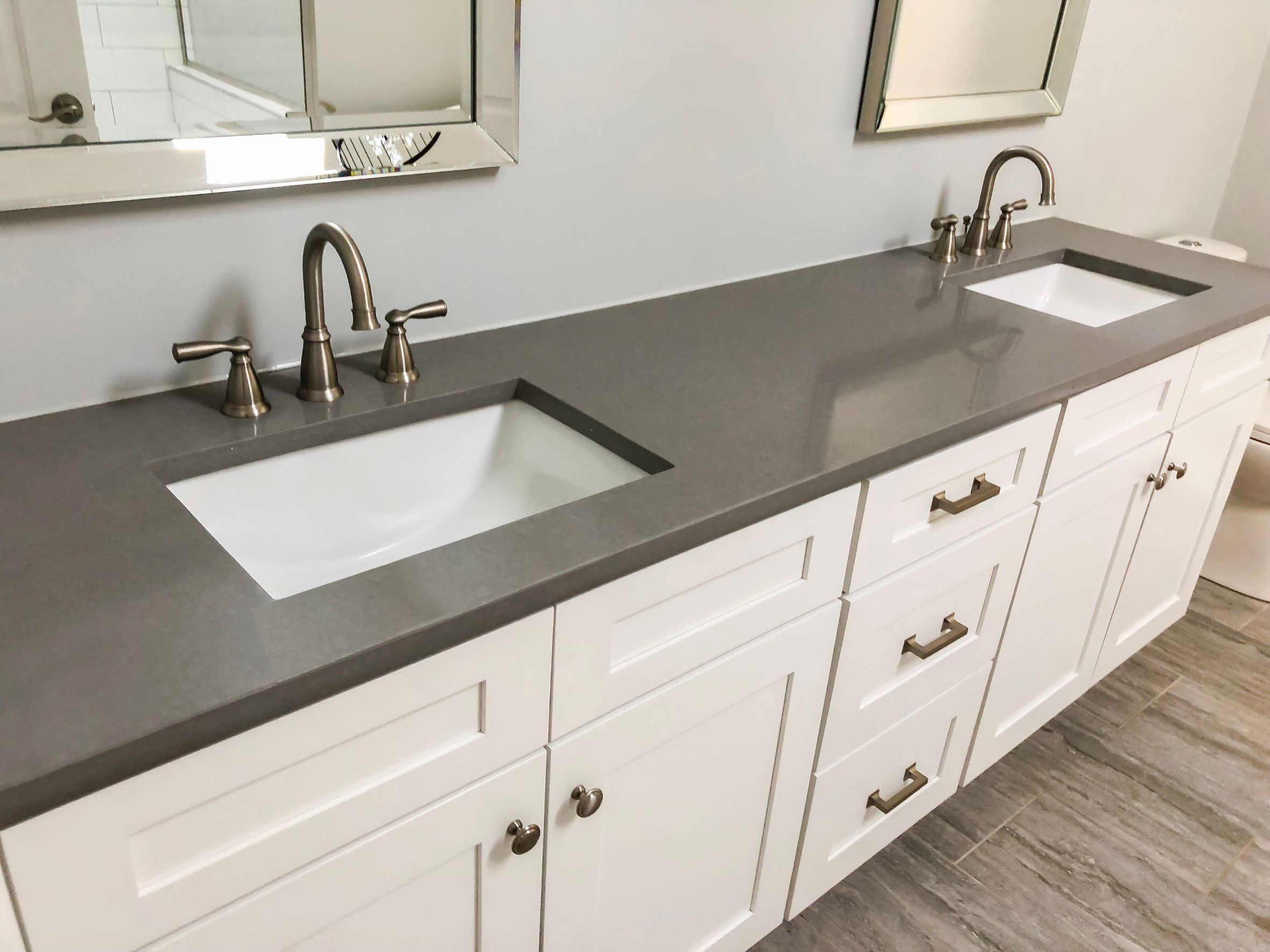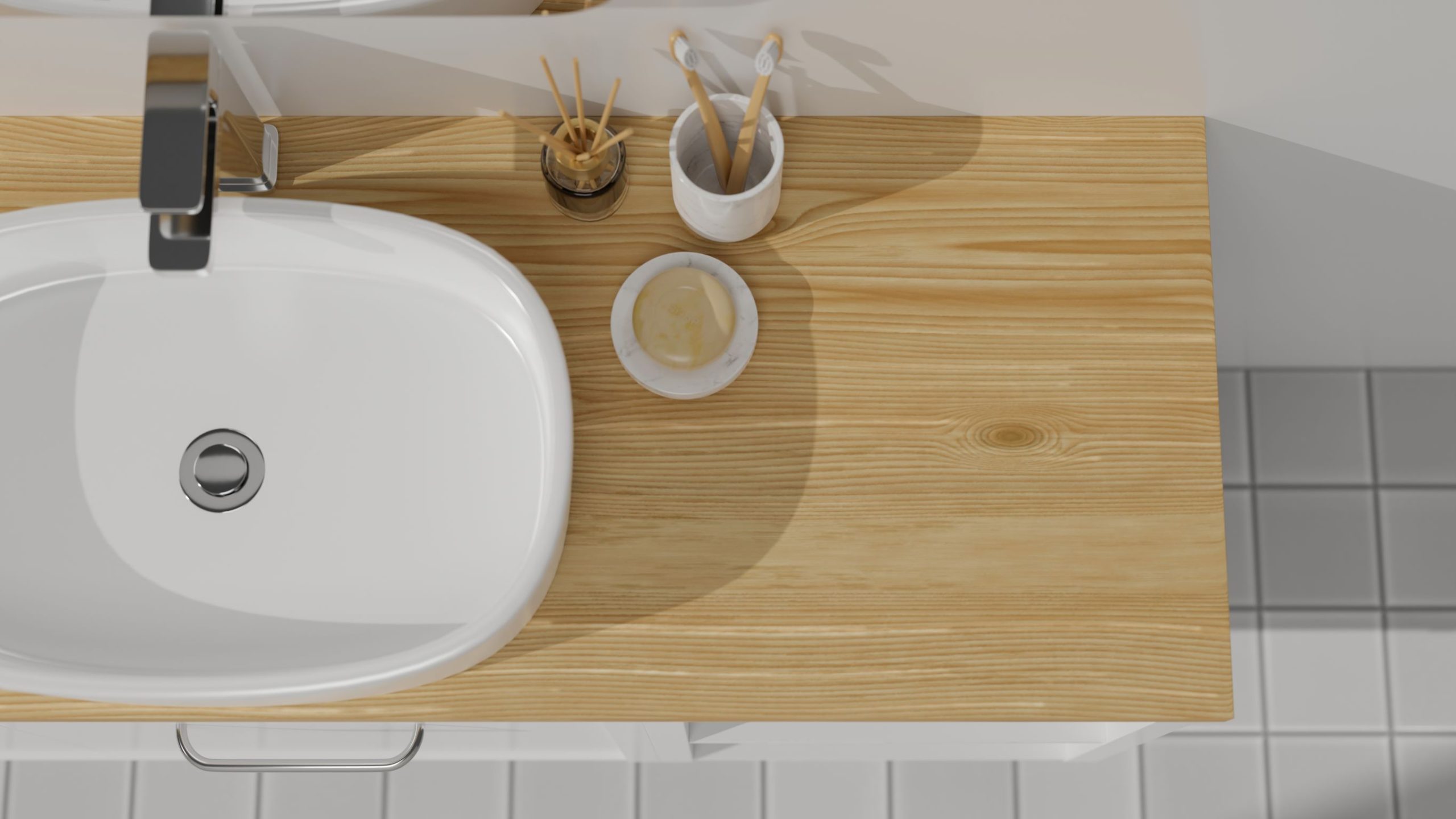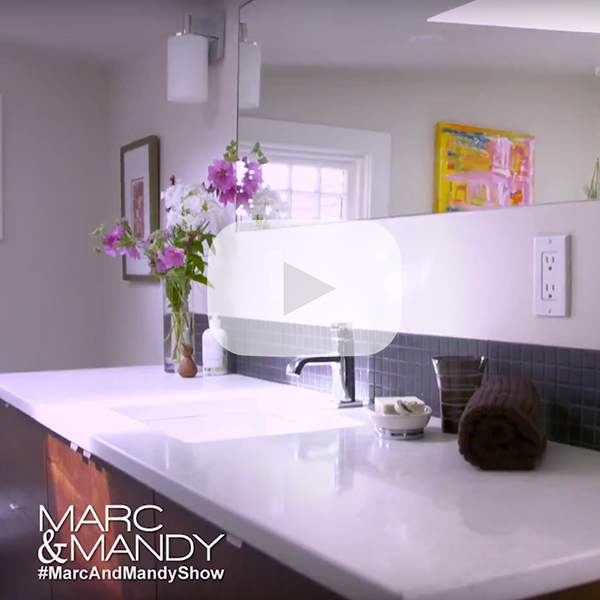In today’s blog post we’ll be talking about choosing the right countertops for your dream bathroom. There are a variety of materials to choose from with differing price points as well as pros and cons for each one. So, of course, that means you have yet another bit of research to do and another choice to make!
There are 4 main material options:
- Plastic Laminate
- Solid surface
- Stone – natural – granite, marble, soapstone and manufactured/engineered
- Wood/Live edge/Bamboo/Butcher Block
And 4 others that have been popular at one time or another:
- Concrete
- Tile
- Glass – recycled slab, high-tensile
- Metal – Stainless Steel, Zinc, copper, bronze
Plastic Laminate Countertops
This option is the easiest on your wallet but no need to fret over it being dull. There are lots of patterns, wood grain and stone looks or options to satisfy the retro or Mid-century look – boomerang motifs included. The tops are constructed from the thin layer of laminate being bonded to a substrate like particleboard or MDF.
Pros – budget friendly, lots of variety
Cons – considered “cheap” so not the best for resale, not as durable as other options as they can peel, chip and scorch
Solid Surface Countertops
This is a man-made material that was created as an alternative to natural stone options. It’s made with blends of synthetic acrylic and polyester materials held together with resins and shaped into slabs.
Fun fact: DuPont was the first manufacturer and created the brand name Corian. And after the patent expired other brands arrived on the scene and may include: Avonite, Gilbralter, Staron and Mystera.
Pros — it’s nearly non-porous, homogeneous, easy to work with and be repaired, affordable upgrade over laminate.
Cons — scratches, may experience heat deformation (more of an issue in kitchens than in bathrooms).

Stone Countertops
What’s the difference between a natural stone slab and a manufactured or engineered countertop slab? Before we begin, here’s the basics of each.
Natural Stone
Natural stone has literally been around for millions of years. Huge blocks of granite, marble, slate, quartzite and other types of stone are quarried from the ground, cut, and sliced into slabs, and polished. No two slabs are identical because nature doesn’t repeat itself.
Special mention under natural stone would be soapstone, which is a favourite of mine, if you can find the right slab. Soapstone can range in hardness, so you have to be careful unless you are cool with scratches that eventually create a lovely rustic patina.
Manufactured Slabs
Are clearly not found in the wild, quarried and cut into slabs etc. so they are not entirely natural. The slab products are created in a factory by combining pulverized natural stone waste bits with pigments and binding it together with resin or acrylic. It is 93-95% ground natural stone combined with 5-7% polymer resins. Essentially, it’s an engineered stone instead of one made directly by mother nature.
They have a variety of brand names: Cambria, Caesarstone, HanStone, Silestone, LG Viaterra, MSI Q Quartz
Now we know the differences between the two — how do they compare??
Colour
- Natural: Varies slab to slab, every countertop is unique.
- Manufactured: Homogeneous – good colour consistency throughout.
Durability
- Natural: Granite is usually very hard and durable. Other types of stone, like marble and soapstone, are softer and more prone to damage and maintenance.
- Manufactured: Practically maintenance free, resists staining, scratching, heat and impact resistant, can mimic almost any other stone.
Porosity
- Natural: All-natural stone is porous and must be sealed periodically to avoid staining. Especially the designer favourite – Carrara Marble.
- Manufactured: Nonporous. Does not require sealing.
Cleaning
Both clean easily but you’ll want to avoid abrasive cleaners especially with natural stone.
Seams
- Natural: Can be quite visible, especially on slabs with large patterning.
- Manufactured: Usually inconspicuous, especially between slabs of consistent colour, but can be visible with wild patterns
Other decisions to make
Slab thickness?
Today 2cm or 3 cm are the most popular options. You can also create a built-up edge – basically joining one or more layers of slab together at the edge to allow for the top to appear thicker or for a profiled edge
Edge profiles?
Ornate decorative edge profiles were pretty hot in the 80’s and 90’s – ogee’s, dropped rounds, full bullnosed and more.
Today, the common style is to do an eased edge and many inspiration pictures clients bring us for islands show a mitered waterfall edge where the horizontal countertop surface is mitered at the ends and continues to the floor. It can be an effective designer look but getting outlets at the ends to meet electrical code is sometimes problematic if an uninterrupted effect is desired.
Finishes?
There are a number of classic options like polished and more specialized ones like leather to consider and that also have cost impacts. As expected, any finish that requires multiple processes will have a surcharge.
Granite: Polished, honed, leathered, caressed, flamed, bush hammered
Marble: Polished, honed, leathered, sand blasted
Manufactured: Natural/satin, Polished, honed, concrete (similar to honed but has a tactile effect), rough, suede, volcano
Which type of stone countertop is best?
Both Natural and manufactured slabs can each be an excellent choice. Most of our clients choose manufactured countertops because of the durability and easy maintenance. Costs for high-quality manufactured and natural slabs are comparable, but you will pay more for extremely unique natural slabs with lots of “movement,” If you want to make a bold statement, a natural slab would be the natural choice.
Pro-Tip: Often fabrication shops have “bone yards” where the off-cuts get stored and because vanity tops are smaller than the typical kitchen you can often save a bit of money as you don’t have to buy a whole slab. And many fabricators have popular options that they price by the square foot which saves you buying the whole slab as well. So it pays to ask if either of the those options might be available to you.
Wood Countertops
Great option to use when looking to bring in a warm feel but wood and water don’t play well together so not a great option around a sink – but if you REALLY want wood a powder room might be the place as its usually less used than a primary family bath
Pros
- Are considered the most “green” of all countertop options
- Unique & classic look
- Can be refinished to look like new if a manual finish is used vs lacquered
- One of the few materials that can be installed by homeowners
Cons
- Prone to scratching, denting, burning, and staining
- Porous surface is sensitive to liquids – may be better suited to a powder room rather than your main bathroom
- Must be maintained

Concrete Countertops
Two people at about the same time cast their first tops in the mid-1980s ….Buddy Rhodes and Fu-Tung Cheng so you could say they are the co-fathers of this particular option. It became popular even trendy in the ‘90s especially with the DIY potential. I’ve known a couple of people who tried it with varying degrees of success. I’d personally have a pro fabricate it. The beauty of concrete is that you can customize it 18 ways to Sunday. Texture, colour, finishes, addition of additives like glass all contribute to making it a one-of-a-kind element in your space.
Pros
- Energy efficient – it’ll capture the heat in your home and then release as the ambient air cools
- they can be shaped to any size or thickness
- offers the unique factor
- heat resistant
- modern looking
- uniform with no seams regardless of how big for the most part….
Cons
- Must be sealed to protect from stains and water
- will show scratches even with sealers
- they are very heavy, and your cabinetry may need additional structural support – especially if you are using a knock-down style from a big box store
Tile Countertops
I will admit that I have a hate-hate relationship with tile countertops. In our first house, the kitchen had tiled countertops and over its life before we purchased it the grout had seen better days, the tiles cracked and the surface was not even, so many a glass was broken….but I digress. Tile is an option and has been used in the past. Different sizes and tile materials like ceramic, modular stone products like granite are used as a low cost option and DIY’ers can install themselves so I guess that would go in the pro column?
Pros
- Second only to laminate for being budget friendly
- As I mentioned, DIY’ers can install
- lots of colour options to mix and match with design styles
Cons
- Grout is hard to keep clean and may be susceptible to bacteria
- Look is “cheap” and may affect resale
- Tiles can often chip and crack over time
Glass Countertops
Glass is not overly common, but it is used, and in the right space can be an effective design element. Crushed glass countertops are newish to the market and are encased into acrylic. High-tensile glass that is fabricated for a kitchen application and specific to your cabinetry or design can be backpainted, etched, coloured and textured. I’ve also seen integrated glass top and sink basins on beautiful furniture style bases – again more suited to a powder room.
Pros
- Most glass is considered eco-friendly
- Crushed has a large range of colour options
- All are easy to clean, durable, stain & heat resistant
- Non-porous, which makes them very hygienic
- Highly customizable
- Good for modern designs
Cons
- While durable, glass can still be prone to cracking or chipping if heavy objects are dropped on them
- Higher costs
Metal Countertops
Last on the list for today are metal countertops – Stainless Steel, zinc, copper, and bronze. Historically used in commercial kitchens or bars, Stainless Steel is the one to most likely make the jump to a work zone residential application and copper, bronze or zinc being softer used more as accents at a wine bar area for an antique look.
Pros
- Stainless is germ-resistant, easily cleaned
- Copper/Zinc/bronze are show stoppers, develop beautiful patinas over time through age and wear….unless sealed but I’d personally question why one would do so when the patinas are so lovely, are unusual and evoke a luxurious design feel
- Copper is naturally antimicrobial, all are easily cleaned
Cons
- They are all fairly pricey and require custom fabrication,
- Prone to scratching, dents and unless you want a countertop that develops “character” over time these are probably not for you
I know this was a lot of info to take in, but I hope it has provided fuel for thought and that you feel armed with more knowledge and feel more confident about choosing a countertop material.
To listen to the full episode and read the show notes, visit www.AllThingsRenovation.com or click on the Podcast tab at the top of our homepage at www.woodbeart.com.


